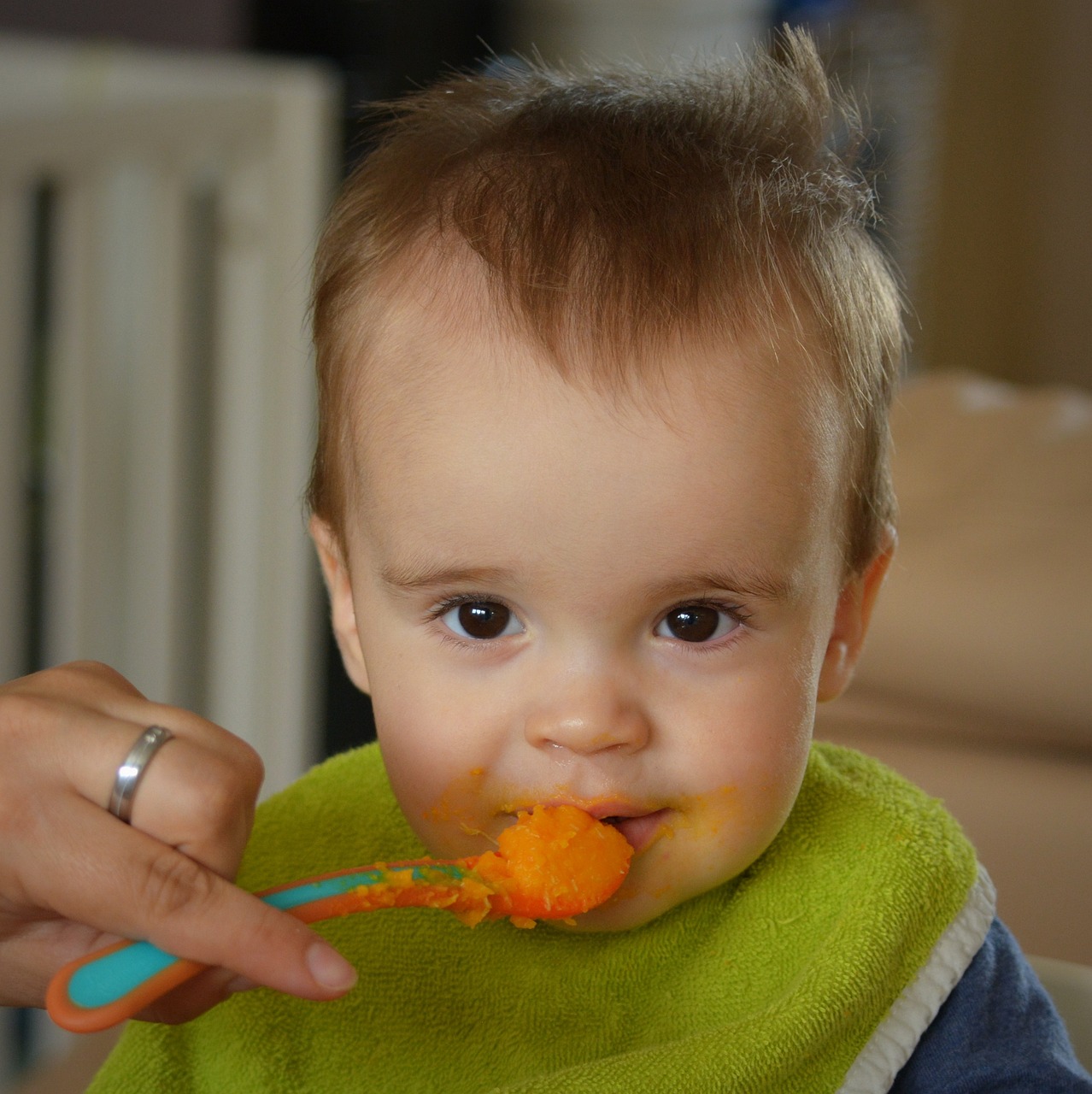Healthy eating
Healthy eating isn’t just about the food children eat, it is also about behaviour around eating.
Children, especially toddlers, need clear boundaries. Don't let all those good eating habits disappear as your baby gets older.
Try not to reward with food and do not let others either. If grandparents want to offer treats suggest sticker books, reading books or an outing instead.
These are some tips for enjoying food:
Mealtimes
Make mealtimes a family and social event. Sit together and turn off screens and TV. This encourages slower eating which in turn reduces the amount we eat. We all tend to eat more when distracted by a screen.
It is important to have regular mealtimes so that your child becomes used to eating at certain times of the day.
There are many options for healthy snacks in between main meals including vegetable sticks and fruit.
It is important to encourage your child to feed themselves (finger foods or spoon foods). Children are good at knowing when they are full but we tend to keep encouraging them to eat more.
At mealtimes allow older children to serve themselves.
Avoid drinks which are full of sugar. This includes pure fruit juice and fizzy drinks. These are also not good for teeth. Tooth decay is totally preventable. Water is the best drink for children.
Food shopping
We understand that it is not possible for many parents and carers, but try and use any opportunity to involve your children in the food shop. This will give them an idea of where their meals are coming from. It can also spark an interest in a particular food item that they like the look of. The supermarket will open their eyes to many new products. It will encourage them to try more whilst also helping in the decision making. Sometimes fresh fruit and vegetables can be expensive. You could try frozen fruit and vegetables which have the same healthy effect and often cost less.
If you’re more than 10 weeks pregnant or have a child under 4, you may be entitled to get help to buy healthy food and milk.
Recipes and cooking
Start 4 Life can provide you with lots of interesting, inexpensive, and simple recipes for your baby or toddler.
Change 4 Life provides the same quality recipes but for children 1 years and older.
The Henry website also has recipes.
It's worth cooking in bulk too because this means you will have home made ready meals available for super quick healthy dinners. There are many stages to cooking a meal and you can get the whole family involved.
Fruit and vegetables
To increase your child’s interest and appetite for vegetables, it is a great idea to involve them in the recipe and shopping stages. By doing this together your child will become aware of everything that is available and can show a preference in terms of a recipe or ingredients. Your child will enjoy having a say in what your family eats and you can make a challenge out of trying new types of food.
Take time to explore the supermarkets and talk to your child about all the different types of fruit. Make it a challenge to try as many fruits as possible. Listen to what your child says about each one. When they tell you what they like, you could start a game in which you could include fruit in different forms including cereal, fruit bowls or a make your own ice lolly.

Fussy eating
We know that fussy eating (not just for toddlers) is common. Children refuse to eat certain foods, eat a very limited range of food or refuse to eat at all.
Do not worry if your toddler refuses something to eat. Adults can create fussy children because we tend to over interpret likes and dislikes. In fact, children cannot make real choices before they reach 4 to 5 years old. Offer them what you expect them to eat. If they choose not to eat it do not be tempted to offer something else. They will eat when they are hungry.
The following things may help:
- Eat together as a family and eat the same meal. Ensure that your child has an appropriately sized portion and that their food does not have any added salt
- Keep offering new foods and in different ways e.g. offering carrot cooked, uncooked, grated, mixed in a sauce etc.
- Praise your child when they try something new
- Aim for no more than two snacks a day
For further information visit the NHS webpage on fussy eaters.
Snacks
Don't let older children get into the habit of helping themselves to food from the cupboards or fridge between meals. This is often a sign of boredom and the calories soon add up. Make sure they always ask and if you think they have had enough to eat or there is a meal coming up, do not allow it.
Set boundaries about eating. Children often demand food or insist they are hungry when you know they have had enough to eat. They are often bored or thirsty.
Remember that being hungry is normal before meals. Otherwise we would have no appetite. Children need to learn to wait.
Use the free NHS Food Scanner App. Just scan the barcodes of your family's favourite foods. Swipe to see the healthier options available and make a swap next time you shop!
Healthy Lunch Boxes
The Henry website gives some good suggestions for packed lunches.
It's important to make sure the lunch box your child takes to nursery or school provides a healthy and balanced lunch. This means plenty of good quality foods from the 5 food groups. Avoid giving too many processed or ready made foods as these usually contain fewer good nutrients and often have more salt and sugar.
A balanced packed lunch should contain:
- starchy foods: these are cereals, bread, rice, potatoes, pasta. Starchy foods are a good source of energy and should make up a third of the lunchbox
- protein foods: including meat, fish, eggs, beans, and tofu/quorn
- a dairy item: this could be cheese, a yoghurt or milk as a drink
- vegetables, raw or cooked
- a portion of fruit
- water or milk to drink
Children often like food they can eat with their fingers. Chop up raw vegetables such as carrots or peppers and give them hummus or cottage cheese to dip them in. Breadsticks and wholemeal crackers are great finger foods that can be paired with cheese pieces.
Replace chocolate bars and cakes with fresh fruit. Vary the fruit each day and get them to try new things. You could also make up a tasty fruit salad. Be inventive and encourage your children when they try something new. Some good ideas can be found here
Note that dried fruit is no longer recommended as a between meal snack as it's high in sugar and can be bad for teeth.
Your child will be able to get free school meals if they are in reception class, year 1 or year 2.
Families who are on benefits or a low income may be eligible for free school meals and healthy start vouchers for their children, so please visit your local council website.
How much sugar should children be eating?
- Children aged under 4 should have no more than 12g or 4 teaspoons of free sugars per day
- Children aged 4 to 6 should have no more than 19g or 5 teaspoons of free sugars per day
- Children aged 7 to 10 should have no more than 24g or 6 teaspoons of free sugars per day
- Children aged 11 years and upwards, as well as adults, should have no more than 30g or 7 teaspoons of free sugar per day
An example of the sugar content of common lunchbox items includes:
- A petit filous fromage fraise (80g) contains 2.5 teaspoons of free sugar
- Barney bear cake bar (chocolate) contains 2 teaspoons of free sugar
- No added sugar fruit shoot drink (apple and blackcurrant) contains 1 teaspoon of free sugar
This calculated together is 5.5 teaspoons of sugar in a standard lunchbox. This means in one meal, a child under 4 will have exceeded their daily intake by 1.5 teaspoons.
Click here for more information from Change4Life
Vitamin Drops for Babies and Children
It is recommended that all children aged 6 months to 5 years are given vitamin A, C and D supplements each day (vitamin drops). That’s because growing children, especially those who are a bit fussy with what they eat, often don’t get enough vitamins in their diet. Vitamin A is important for their immune system and keeps their skin healthy. Vitamin C helps them absorb iron (to stop them getting anaemic). Vitamin D keeps their bones strong.
It is also recommended that breastfed babies are given vitamin D supplements from birth. Infant formula is fortified with vitamin D so extra vitamin D is not required.
Your baby or child is entitled to free vitamin drops if you qualify for Healthy Start.
Your health visitor can give you advice about vitamins for your baby. For more information visit the NHS webpage on vitamins

What is Healthy Start?
If you’re more than 10 weeks pregnant or have a child under 4, you may be entitled to get help to buy healthy food and milk.
If you’re eligible, you’ll be sent a Healthy Start card with money on it that you can use in some UK shops. We’ll add your benefit onto this card every 4 weeks.
You can use your card to buy:
- plain liquid cow’s milk
- fresh, frozen, and tinned fruit and vegetables
- fresh, dried, and tinned pulses
- infant formula milk based on cow’s milk
You can also use your card to collect:
- Healthy Start vitamins – these support you during pregnancy and breastfeeding
- vitamin drops for babies and young children – these are suitable from birth to 4 years old
You can use the Healthy Start card to collect Healthy Start vitamins Find healthy start vitamins services - NHS (www.nhs.uk)
For more information on Healthy Start ask your health visitor or midwife, or visit Get help to buy food and milk (Healthy Start).
What if I need more help?
If you need further help and support, speak your health visitor or GP.
Food banks provide free emergency supplies of food. To visit a food bank you may need to contact Citizen's advice, local children's centre or your Health visitor for a foodbank voucher. Click here for details about your local food bank.
Further information:
Visit here for a healthy infant feeding booklet.
Visit first steps nutrition for information on eating well in early years.


